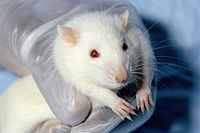
Ethological approach to social isolation effects in behavioral studies of laboratory rodents
Sign Up to like & getrecommendations! Published in 2018 at "Behavioural Brain Research"
DOI: 10.1016/j.bbr.2017.12.022
Abstract: HighlightsEthological approach helps to understand the housing effects on rodent behaviors.Effect of isolation rearing depends on social relationships with cagemates when isolated.Isolation rearing during critical developmental period induces behavioral agitation.Short‐term isolation rearing disrupts social transmission… read more here.
Keywords: isolation rearing; housing; laboratory rodents; isolation ... See more keywords

A review of methods used to kill laboratory rodents: issues and opportunities
Sign Up to like & getrecommendations! Published in 2022 at "Laboratory Animals"
DOI: 10.1177/00236772221097472
Abstract: Rodents are the most widely used species for scientific purposes. A critical pre-requisite of their use, based on utilitarian ethical reasoning, is the provision of a humane death when necessary for scientific or welfare grounds.… read more here.
Keywords: review methods; kill laboratory; welfare; laboratory rodents ... See more keywords

Models and detection of spontaneous recurrent seizures in laboratory rodents
Sign Up to like & getrecommendations! Published in 2017 at "Zoological Research"
DOI: 10.24272/j.issn.2095-8137.2017.042
Abstract: Epilepsy, characterized by spontaneous recurrent seizures (SRS), is a serious and common neurological disorder afflicting an estimated 1% of the population worldwide. Animal experiments, especially those utilizing small laboratory rodents, remain essential to understanding the… read more here.
Keywords: spontaneous recurrent; detection spontaneous; models detection; laboratory rodents ... See more keywords

Dim Light at Night and Constant Darkness: Two Frequently Used Lighting Conditions That Jeopardize the Health and Well-being of Laboratory Rodents
Sign Up to like & getrecommendations! Published in 2018 at "Frontiers in Neurology"
DOI: 10.3389/fneur.2018.00609
Abstract: The influence of light on mammalian physiology and behavior is due to the entrainment of circadian rhythms complemented with a direct modulation of light that would be unlikely an outcome of circadian system. In mammals,… read more here.
Keywords: night; light night; physiology; lighting conditions ... See more keywords